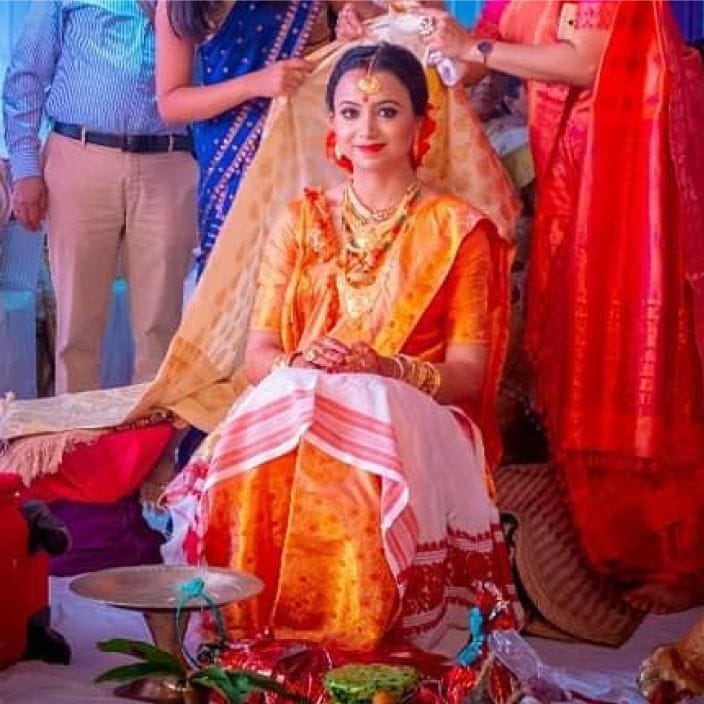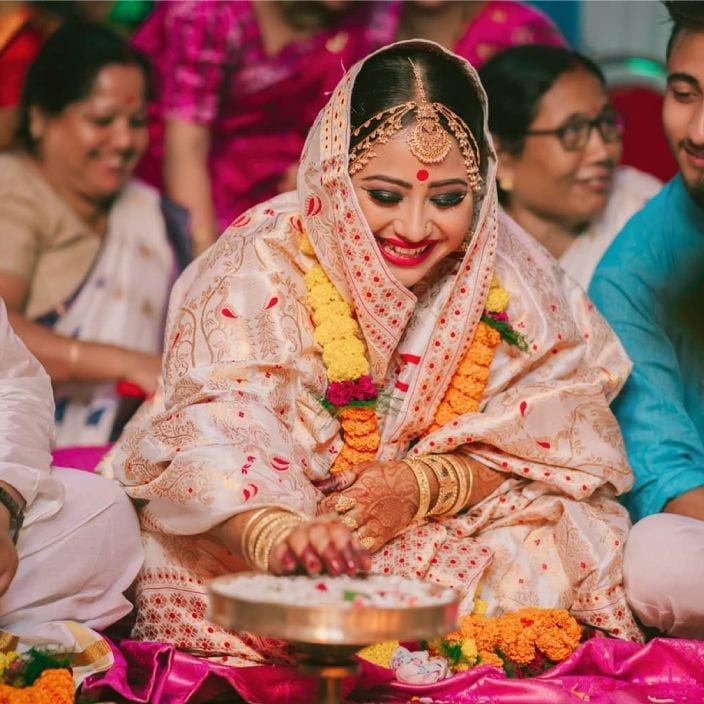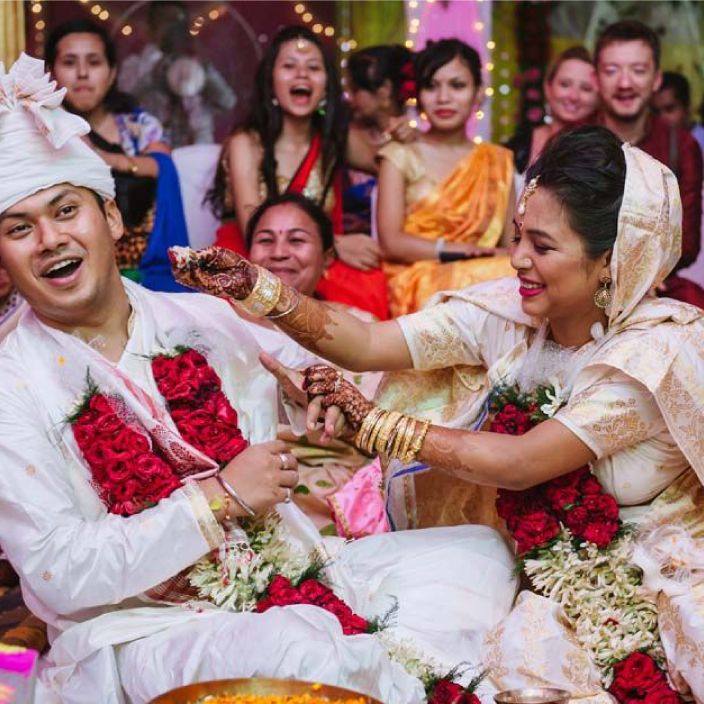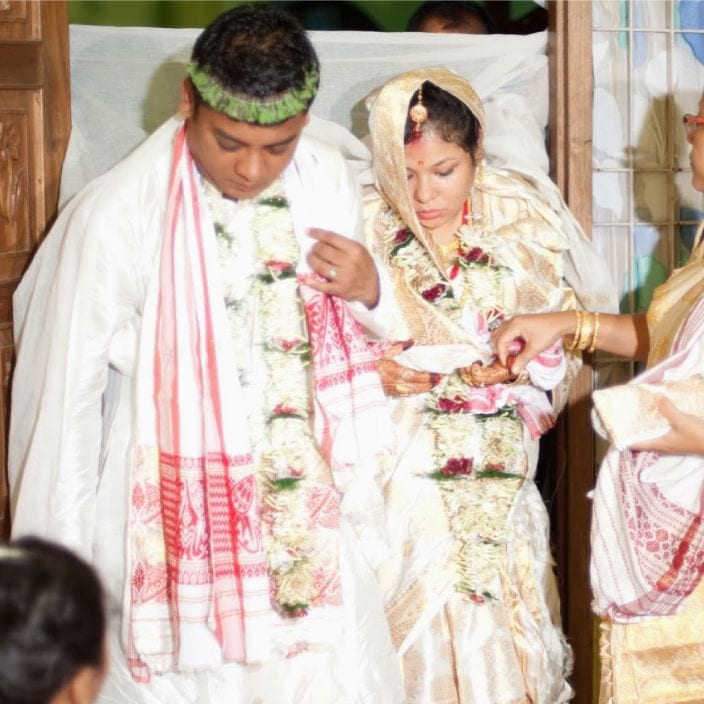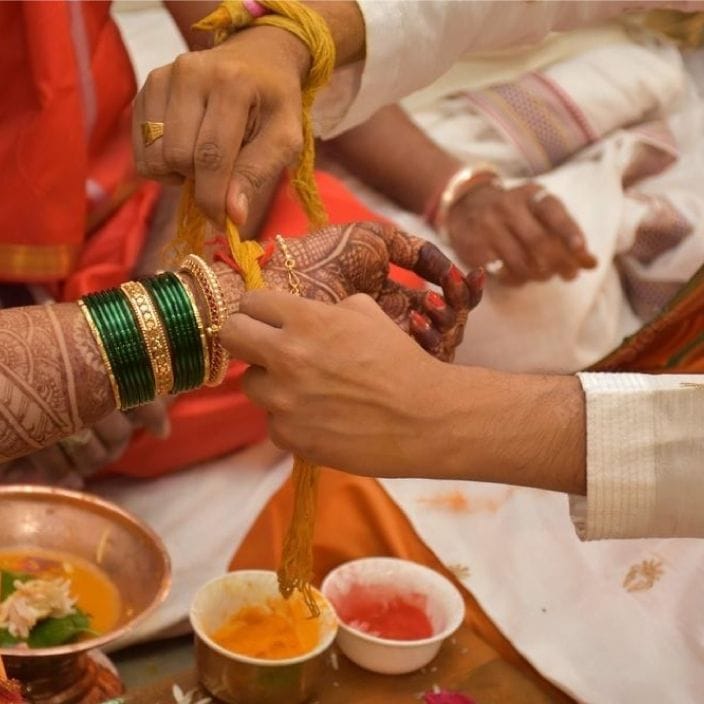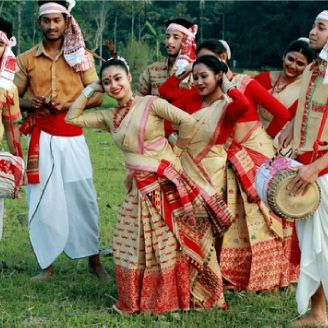For best prices and early deliveries, WhatsApp us at. 918488070070
Assam
Assam is a beautiful, green state in the Northeast, known for its tea gardens, silks, and rich culture. Traditional Assamese weddings are a mix of age-old and modern ceremonies filled with warmth and care. It is a chance for the community to celebrate the groom and bride as well as their families, making it a fun, grand affair. The state is an amalgamation of different religions, cultures, and languages. Most of the state’s population follows Hinduism, with the three prominent sects being Shaivisim, Shaktism, and Vaishnavism. Besides Hindus, Assam also has Muslim, Christian, and Buddhist communities as well as a major tribal population. The Bodo-Kachari ethnic group is made up of nineteen major tribes, while the other ethnic groups include the Tai Ahoms, Chutias, Morans and Borahis. Many of the rituals in Assamese weddings, also called Biya, are based on Hindu scriptures; they are different from the rest of the country because of the assimilation of its unique regional communities.
Tracing the Traditions
Weddings in Assam begin with a series of pre-wedding rituals. The first ceremony, Juran Diya, is held a few days before the wedding, where the groom’s mother and her relatives visit the bride. They give her gifts of Pan and Tamul, betel leaves and nuts, and a Gamusa, a white traditional Assamese with red thread embroidery. This is followed by the Tel Diya ritual, where the groom’s mother puts a ring and betel nut on the bride’s forehead and pours oil thrice. In other Hindu traditions, the groom applies Sindoor on the bride’s forehead. In Assam, it is customary for the groom’s mother to perform the ritual instead.
In the Pani Tola ceremony, the mothers of the bride and groom head to a nearby pond or water to collect water while other women walk with them, singing traditional wedding songs or Biya Naam. On their trip, they must carry a brass candlestand with a diya, rice, betel nuts and leaves, a coin, and a knife. While returning, they must walk back without looking back, or it is considered bad luck. Another tradition for good fortune is Daiyan Diya, where the groom sends his bride curd, of which she eats a little and sends back to he groom to share.
A big part of Assamese weddings is paying respect to your ancestors and involving them in the ceremonies. In Nau Purushor Sharddho, the fathers of the bride and groom ask for blessings from the previous nine generations. Assam also has its own version of the North Indian Haldi ceremony and South Indian Mangal Snanam called Nuoni. In this ceremony, the bride and groom bathe in the water from the Pani Tola. Their mother applies oil, curd, and maah-halodhi, a paste of lentils and turmeric, on the couple’s face and arms. Another unique aspect of weddings in Assam is that they have a Reception before the wedding. The couple invite their family and friends for a fun celebration and, per tradition, offer them saunf or fennel.
With the pre-wedding rituals done, the weddings can finally take place! The wedding day starts with the groom arriving in full fanfare at the bride’s home or wedding venue only to be asked to pay money to enter. This is a rather fun custom called Dora Aaha that leads to some haggling and negotiations.
Once the debt is paid, the bride’s mother performs an aarti, and the bride’s sister washes the groom’s feet. The groom is then carried to the mandap by the brother. Meanwhile, the bride is given panch – a mixed drink of milk, curd, honey, ghee, and sugar – and also carried to the wedding stage on the shoulders of her uncles and brothers.
The wedding, or Biya, follows Vedic customs. A priest conducts the ceremony, which takes place around a sacred fire and involves the couple and their families. The father of the bride gives her away in the Kanyadaan rite, while the brother offers puffed rice to the bride to offer to the fire. The guests gather around the mandap, sing Jura Naam, blow conch shells, and women make ululations. The bride and groom make their wedding vows during Saptapadi by walking around the fire seven times with their clothes tied together. The bride also steps on seven betel leaves with her right foot. Their elders bless them during Aashirbaad and Maan Dhora.
At some weddings, the couple play traditional games called Khel Dhemali, such as hiding the couple’s rings in a bowl of milk and the first one to find it wins. After the fun and games, the bride must say her goodbyes to her family. She throws handfuls of rice over her shoulder as she leaves the wedding venue to repay her parents for raising her.
The rest of the post-wedding rituals take place at the groom’s house. In Ghor gosoka, the bride steps on a flat dish with milk and enters the home by breaking a Saaki, a clay lamp. After this, she heads back to her parents' home, and the next morning, the groom goes over for the Khuba Khubi ritual. The couple leaves together to go to their new home, where their family decorates their bedroom with flowers in a tradition called the Phool Soja.
Wedding Attire
An Assamese groom's wedding look consists of a kurta and dhoti worn with a Cheleng, a traditional shawl draped around the neck. The Cheleng is made from Muga silk, one of the state’s most coveted textiles. The groom completes his look with a Pagri, a traditional headpiece that adds elegance and signifies his status. He may also wear minimal jewellery, such as a gold chain and rings, and Juti (traditional footwear) to complete the look.
The bride wears a Mekhela Chador, pronounced 'Mekhla Sador', a two-piece ensemble that is similar to a saree. It has a thick skirt with pleats in the front, called Mekhela, and an upper garment, Chador, that is tucked into the skirt and draped over the shoulder. Traditionally, the bride ties a garment called Riha around her chest. Although, most modern brides prefer to wear a fitted blouse.
The Mekhela Chador is typically made from Muga, Pat, or Eri silk and embroidered with heavy gold and silver zari. While ivory or off-white colours are the traditional choice, the bridal ensemble can also come in pastel shades, reds, and greens. The designs in her outfit are often inspired by Assamese flora, fauna, and folklore as well as local Jaapi and Gamosa motifs.
No Assamese bridal look is complete without beautiful gold jewellery. Traditional pieces include Jon Biri, a heavy gold chain with a large moon-shaped pendant encrusted with rubies, emeralds, or pearls. She can also wear a Dholbri necklace, a unique ornament wiith silk beaded threads and a drum-shaped kundan pendant. Some other necklace options are Golpata, a floral choker; Kerumoni, a long necklace with a round gem-laced pendant, and Loka Paro, a beaded necklace with pigeon-shaped pendants. The bride can pair these with gold chandbalis, jhumkas, or Thuria stud earrings.
Of the many ornaments in her bridal trousseau, a particularly charming addition is Matha Tikka (Maang Tikka), a delicate headpiece with a dangling pendant that rests on her forehead. She can also wear a Gamkharu, a thick gold bangle, on each wrist, along with thinner gold and glass bangles. Her hair is tied up in a bun or braid and decorated with fresh flowers, hair pins, and delicate chains. She also has altra on her palms, fingertips, and feet.
Traditional Cuisine
Assam shares similarities with its neighbouring Northeast states and West Bengal but has its own distinct cuisine. For weddings, there is an elaborate feast with fried ‘Bor’ appetisers, fish curries, and vegetarian dishes. Rica and lentils are a staple of the state and prepared with different herbs and spices. They are served with different stews, such as Masor Tenga fish curry, mangxô meat stew, and the famous spicy Bhoot Jolokia Pork Curry.
Other popular meat dishes are Til Diya Murgi or sesame chicken, Khorika or smoked meat, and Bôralí fish curry. While the Assamese are known to love their mutton, fowl, duck, goose, fish, pigeon, and pork; they also cook some delicious vegetarian dishes.
Pitika is a vegetable delicacy with mashed potatoes, tomatoes, and brinjals. Xaakh Bhaji, a leafy green curry, is a crowd favourite, along with Khar, a tangy dish made with banana peels, raw papaya, and pulses. These can be served with Luchi, a type of fried flatbread.
Khorisa, fermented bamboo shoots, Koldil, banana flower, and squash are also heavily used in their dishes. The wedding meal is incomplete without Payokh, a traditional sweet rice pudding. The meal also features Pitha, a traditional Assamese sweet that is often steamed or fried, typically made with Bora Saul (a type of glutinous rice). Many Assamese communities also brew local beverages such as Laupani, Xaaj, Paniyo, Jou, Joumai, Hor, and Apong. Though these are alcoholic, they are served on special occasions and religious festivities.
Cultural Decor
Everything about Assam weddings is elegant, charming, and meaningful, including their decor. Traditional decorations are used in the bride and groom’s homes and the wedding venue. The couple’s home often has a string of mango leaves tied over every door, known as Aaam dali gatha. It is believed to absorb negative energy from all visitors, keeping the bride and groom safe from bad luck. The focal point of the wedding is the wedding mandap, which is often decorated with drapes and fresh flowers, such as marigolds, jasmine, and roses.
The Assamese also believe a lot in symbolism. Areca nut leaves, Tamul or betel leaves, and bamboo is considered lucky and often used in poojas, torans and wall decor. They are also given as a symbol of love and devotion.
Another common element is the Gamosa, a white silk cloth with a red border on three sides and red woven motifs that carry much meaning to the indigenous tribes. It is used to cover idols of gods and goddesses, worn by the groom, and offered to wedding guests as a sign of respect.
The state also has a rich tradition of craftsmanship in cane, bamboo, and metal craft, which lends itself to the wedding decor. For instance, Xorai is a bell metal standing tray with a curved stand and dome-shaped top, used to make offerings. Jaapi is a conical hat made with tightly woven bamboo that is a cultural and status symbol. Assam weaving is also particularly famous and the wedding venue is often decorated with gorgeous silk and cotton drapes. Other regional crafts include brass crafts, toy and mask making, pottery and terracotta work, and wood crafts.
